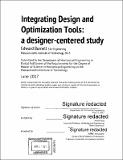| dc.contributor.advisor | Maria Yang. | en_US |
| dc.contributor.author | Burnell, Edward (Edward E.) | en_US |
| dc.contributor.other | Massachusetts Institute of Technology. Department of Mechanical Engineering. | en_US |
| dc.date.accessioned | 2017-10-04T15:07:41Z | |
| dc.date.available | 2017-10-04T15:07:41Z | |
| dc.date.copyright | 2017 | en_US |
| dc.date.issued | 2017 | en_US |
| dc.identifier.uri | http://hdl.handle.net/1721.1/111769 | |
| dc.description | Thesis: S.M., Massachusetts Institute of Technology, Department of Mechanical Engineering, 2017. | en_US |
| dc.description | Cataloged from PDF version of thesis. | en_US |
| dc.description | Includes bibliographical references (pages 21-23). | en_US |
| dc.description.abstract | Exploring design options for additively manufactured parts generally requires separate, sequentially applied software for design, analysis, and optimization. To evaluate the effect of integrating these capabilities within a single tool we conducted a controlled human subjects study. Three tools with different degrees of integration were created for two test cases of structural trusses, and it was found that increased integration improved quality, speed, and efficiency of the design process. After a quarter of their total time with the problems, 50% of designers with a fully integrated tool had a better design than 75% of other designers ever would. After that point, the top 50% of designers went on to explore a design space unreached with other tools. It appears that integration, and in particular the integration of optimization, leads to better performance by making it possible to explore complex designs and achieve outcomes which would be inaccessible to conventional tools. | en_US |
| dc.description.statementofresponsibility | by Edward Burnell. | en_US |
| dc.format.extent | 23 pages | en_US |
| dc.language.iso | eng | en_US |
| dc.publisher | Massachusetts Institute of Technology | en_US |
| dc.rights | MIT theses are protected by copyright. They may be viewed, downloaded, or printed from this source but further reproduction or distribution in any format is prohibited without written permission. | en_US |
| dc.rights.uri | http://dspace.mit.edu/handle/1721.1/7582 | en_US |
| dc.subject | Mechanical Engineering. | en_US |
| dc.title | Integrating design and optimization tools : a designer-centered study | en_US |
| dc.type | Thesis | en_US |
| dc.description.degree | S.M. | en_US |
| dc.contributor.department | Massachusetts Institute of Technology. Department of Mechanical Engineering | |
| dc.identifier.oclc | 1004860869 | en_US |
